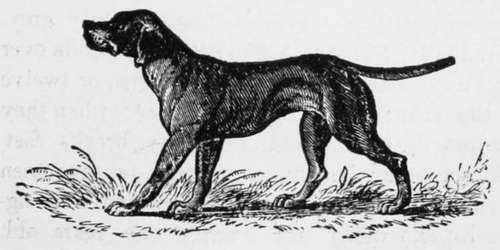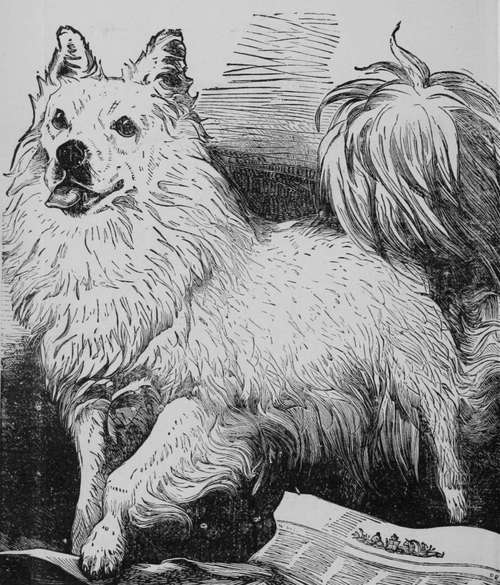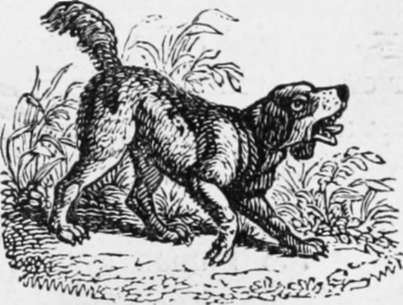Age Of Dogs
Description
This section is from the book "Breeding, Training, Management, Diseases Of Dogs", by Francis Butler. Also available from Amazon: Breeding, training, management, diseases.
Age Of Dogs
Dogs do not, as horses, present any exact criterion of their age; nevertheless, attention to the following points will materially assist us in determining the matter.
At about four years, the front teeth lose their points, and each cf them preasnts a flattened surface, which increases as the age advances; they likewise become less white, and more uneven. The front teeth suffer earlier than the others, and in dogs fed much on bones, or in those who fetch and carry, as it is called, they are very commonly broken out, while the dog is yet young. The holders, or tushes, are also blunted by the same causes. At seven or eight, the hair about the eyes becomes slightly grey. Gradually, likewise, a greyish tint extends over the face ; but it is not till ten, eleven, or twelve years, that the eyes lose their lustre : when they become dim, the dog generally breaks fast though some last fifteen, sixteen, or seventeen years; and I have seen a mother and son vigorous at twenty and twenty one years old. Such instances as the latter must, however, be considered as rare.
In his native state, perhaps, the dog seldom attains to more than fifteen or sixteen years, while such as live in confinement and luxury, according to the degree of their artificial habits, become old at twelve or thirteen. Now and then an extraordinary exception occurs: the oldest I ever knew had reached his twenty-fourth year, and, at the time I saw him, was still vigorous and lively, and neither lame, nor blind, nor deaf. I am not aware that much difference exists between the various breeds, as to the age they arrive at Spaniels I, however, think rather long-lived ; while terriers, on the contrary, I have seldom observed very old.

Gravel
Dogs have stone it is certain; that they therefore have gravel also, it is natural to suppose, though it is not always easy to detect it. I have, however, seen the complaint sufficiently well marked. From ten to twenty drops of oil of turpentine, or twice the quantity of spirits of nitre, twice a day, with a few drops of laudanum added to either in case of much pain, will form the best means of relief.
Husk
This is the popular term in some countries for distemper ; it is also in some others the common name for any cough a dog may have. In Ireland it very commonly implies distemper.
Warts In Dogs
It is not uncommon for dogs to be troubled with warts on some parts of the body; the most frequent of which are the lips, the penis, and the prepuce. These excrecences may be either cut off, or, when they exist in clusters, they may be sprinkled with equal parts of crude sal ammoniac and powdered savine; which commonly effects their removal.
Pulse
From the greater irritability of lesser animals, and the extreme quickness of their circulation, the motions of the heart and arteries, do not present such exact criteria of health and disease, as they do in the horse and other large animals. In cases of very great affection, the action of the heart, and the pulsations of the larger arteries, may, however, be felt with propriety, and will serve as some guide to ascertain the degree of disease. The pulsations will not only be increased in quickness, but will present a vibratory feel in violent inflammatory affections. In inflammations of the lungs they will be very quick and small, but will increase in fulness as the blood flows during bleeding. Something like the same will occur, but not in an equal degree, in inflammations of the stomach and bowels also. As the pulsatory motions, therefore, are not so distinct in the dog as they are in larger animals; so, in general, the state of the breathing, which, in most cases, is regulated by the circulation, may be principally attended to as a mark of greater or less inflammatory action. When a clog, therefore, pants violently, his circulation, or in other words his pulse, may be considered as quickened.


Continue to:
- prev: Fits
- Table of Contents
- next: Hydrophobia-The Spitz
